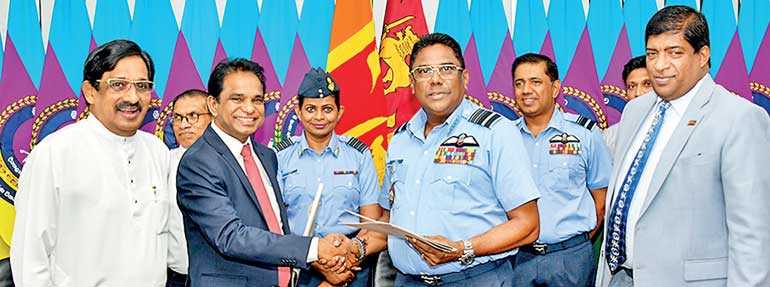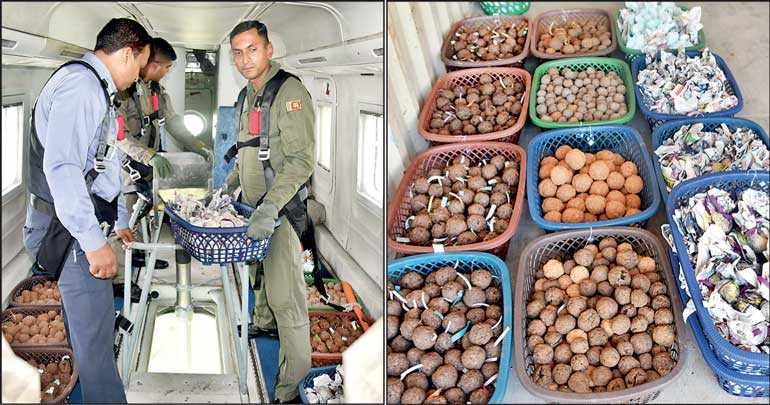Wednesday Dec 17, 2025
Wednesday Dec 17, 2025
Monday, 28 January 2019 01:33 - - {{hitsCtrl.values.hits}}


It was not so long ago, that the Sri Lanka Air Force, hand in hand with the University of Peradeniya and MAS, broke new ground by taking the first steps to explore the possibility of using seed bombing in Sri Lanka’s endeavour to increase the forest cover of the island.The project is in full swing now with the progress of the seeds being studied by the combined experts in order to determine the most efficacious medium and composition of the bombs so that the SLAF will be able to effectively bring its airpower to bear, to address the problem of the fast dwindling forest cover.
|
Y-12 aircraft |
Continuing its determination and drive to use its resources to contribute to the national good under the visionary leadership of the present Commander, Air Marshal KapilaJayampathy, the SLAF this week signed a MoU with the Ceylon Electricity Board, to initiate a project for cloud seeding in order to address the issue of dry weather and its impact on power generation in Sri Lanka.At present, the reduction of water levels of the catchment areas compel the utilisation of thermal energy, which needless to say, comes at a much higher cost and also contributes to adverse impacts on the environment.Adopting effective methodologies to increase the rainfall and to harvest that water in order to utilise it for hydro-power generation can result in substantial savings to the national coffers, while also ensuring minimal harm to the environment.
The process of rainmaking or artificial precipitation is one of artificially inducing precipitation through the use of catalysts such as dry ice and salt powder.Depending on the composition of the clouds and their properties, this is done by using aircraft or rockets, and involve a number of steps: ‘Triggering’, is the activation of the cloud formation; ‘Fattening’, is the promotion of cloud growth; ‘Moving’ is the process of moving the cloud to a designated area; and ‘Attacking’ to initiate rainfall from cloud.
Weather modification extends to dispersion of cloud into clear flight path, prevention of hail formation, and inducing rainfall from stratiform clouds onto a valley or any catchment areas. Seeding may be performed inside or outside a cloud or to the top or underneath any isolated cloud or cloud band.
At present, the reduction of water levels of the catchment areas compel the utilisation of thermal energy, which needless to say, comes at a much higher cost and also contributes to adverse impacts on the environment.Adopting effective methodologies to increase the rainfall and to harvest that water in order to utilise it for hydro-power generation can result in substantial savings to the national coffers, while also ensuring minimal harm to the environment.
The Commander of the Air Force, Air Marshal KapilaJayampathy signed a Memorandum of Understanding (MOU) last week with the Secretary to the Ministry of Power, Energy and Business Development, Dr. B.M.S.Batagoda with respect to the first ever cloud seeding project of Sri Lanka at Air Force Headquarters. The Minister of Power, Energy and Business Development Ravi Karunanayake, and State Minister of Power and Renewable Energy A.D.Premadasa were present for the signing of the MOU.
Speaking after the signing, Air Marshal Jayampathy stated that the cloud seeding endeavour is done with expert assistance from Thailand and that the SLAF personnel involved will receive training from the experts.An SLAF Y-12 Aircraft will be modified to carry out this mission and will be permanently assigned for cloud seeding missions. In the future, there is provision for the CEB to procure two additional aircraft for the SLAF as well.The Commander went on to say that although the initial focus will be on power and energy, that the cloud seeding can also be of considerable benefit for the agricultural sector as well, where those affected by droughts and dry seasons can be assisted with this methodology.